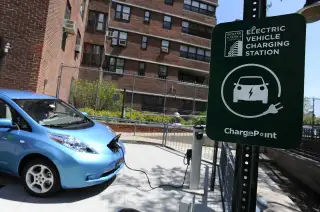Analysts Say You're Gonna Buy an Electric Car, Even if Gas Is Super Cheap

Projections always involve speculation, and they can sometimes wind up being far off the mark. Proponents of plug-in electric vehicles have seemed to be especially prone to wishful thinking. For example, in 2011 President Obama said that 1 million electric cars like the Nissan Leaf, Chevy Volt, and all Tesla models would be on the road in America by 2015. By the beginning of that year, though, a total of only about 280,000 plug-ins had been purchased, and it was clear that sales would come up way short of the goal set by Obama.
So it is probably wise to take with a grain of salt any plug-in sales forecast, including the new one from Navigant Research. It says that plug-in electric vehicle sales in the U.S. and Canada will rise 62% year over year in 2016, to about 200,000 unit sold. Navigant is also anticipating that EV sales will surge in the region to 900,000 in 2020, up to 1.4 million in 2025, as The Detroit Bureau reported.
If the forecast holds up for 2016, sales will have to shoot through the roof for the rest of the year. According to InsideEVs.com, just under 50,000 new plug-in electric sales have been recorded in the U.S. through June 2016, a rise of around 13.5% compared to the 44,000 units sold during the same time period the year before.
What's more, Americans consumers, currently quite happy with cheap gas and SUVs and trucks both big and small, haven't been hopping on the electric car trend at nearly the pace of the rest of the world. InsideEVs.com data shows that while plug-in sales rose worldwide from roughly 320,000 to 550,000 from 2014 to 2015, sales actually decreased during the same period in the U.S., from 122,000 to 116,000.
Read Next: 10 Things You Definitely Do NOT Want to Do With Fireworks
In Canada, plug-in vehicle sales have been rising at a quick pace, but the grand total came to only about 7,000 units in 2015, with a market share of just 0.35% of all sales. So for the Navigant projection to hold up in 2016, it would be quite a busy second half of the year in terms of electric car sales in North America.
Cheaper EV batteries, improved driving range from electric car pioneers like the Nissan Leaf, and the forthcoming introduction of new affordable plug-in models like the Chevy Bolt and the Tesla Model 3 are all regularly cited as reasons that electric cars will take over a large portion of the market very soon down the road.
Yet many other factors are in play. Most plug-in vehicle purchases are now subsidized with government tax credit and cash-back incentive programs, and it's unclear how long they will be around. The charging stations and other infrastructure needed to handle the mass adoption of EVs isn't anywhere near it would have to be. The future of self-driving vehicles is a big question mark, especially because Tesla just confirmed the first fatality in a car controlled by autopilot.
Cheap gas, forecast to dip back below $2 a gallon nationally by fall, undercuts the financial argument for buying a car that runs on electric power. As electric car sales increase, the global demand for oil will decrease, and as a result gas is likely to get even cheaper, further throwing a wrench into the predicted broad transition to EVs.
Nonetheless, another forecast, published by Bloomberg New Energy Finance earlier this year, predicted that plug-in sales would hit 41 million worldwide by 2040, accounting for 35% of all new light-duty auto sales. "Our central forecast is based on the crude oil price recovering to $50, and then trending back up to $70-a-barrel or higher by 2040," the author of study explained. What happens if oil instead gets cheaper? "Interestingly, if the oil price were to fall to $20 and stick there, this would only delay mass adoption of EVs to the early 2030s."
Read Next: 10 Things Americans Have Suddenly Stopped Buying
Clearly, the analysts believe that if EV sales are flattening out or rising to an underwhelming degree lately, it's only because the industry is recharging, so to speak, and that the long-awaited period of widespread adoption is coming in the very near future. So which, if any, of these projections will become reality? We'll all learn just a little ways down the road.